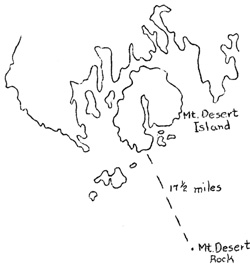

|
|
NATURE NOTES FROM ACADIA

What kinds of birds meet death by flying into the lighthouse beacons along the Maine coast? In an effort to answer this question I enlisted the aid of the Lighthouse Service. Early in the year Mr. Thomas Sampson, Assistant Superintendent of Lighthouses at Portland, Maine, expressed his eagerness to cooperate in the undertaking, and from him I received the names, stations, and addresses of 15 lighthouse keepers along a stretch of rugged and very irregular coast extending from Libby Islands Light Station, Machias Bay, to and including Marshall Point Light Station at Port Clyde. This represents an airline distance of over 100 miles, the center home of which is near Mount Desert Island, the home of Acadia National Park. In order to facilitate the mailing of dead birds which were found by the lighthouse keepers in the immediate vicinity of the light, addressed government tags were furnished, and the keepers were instructed to mail the packages at their earliest convenience. Copies of a so-called "information sheet" were also furnished, and the men were urged to fill this out and send it on in the same mail. Among the questions asked on this sheet were the following:
On May 11 a package containing 32 dead birds was received from Mr. George W. York, keeper of Mount Desert Light. The small rocky isle on which this light is built, one of the most isolated lighthouses on the entire Atlantic coast, lies 17½ miles southward of Mount Desert Island and 22 miles from the mainland. Its gray granite tower, 58 feet high supports a revolving white light (see cover illustration) which is visible 14 miles away. The birds which met death by flying into the light on the nights of May 5, 6, and 7 were as follows:
On the nights of May 15, 16, and 17 more birds were lured to their death by this solitary revolving beacon. These were as follows:
On the night of May 14 a Swamp Sparrow and a Northern Yellowthroat crashed into the light on Monhegan Island. This lighthouse, 50 or 60 miles southwest of Mount Desert Island, lies nine miles off the mainland at the eastern entrance to Muscongus Bay. Its fixed white light, 178 feet above the sea, is varied every minute by a white flash.
Libby Islands Lighthouse, the easternmost primary light station in the United States, stands in the middle of the entrance to Machias Bay. Its fixed white light, elevated 91 feet above the water, is visible for 15 miles. On the morning of May 17 Mr. H. H. Wass, lighthouse keeper, found the following dead birds at the foot of the tower:
On the morning of May 17 a White-throated Sparrow and one Northern Yellowthroat were found at the foot of Matinicus Rock Lighthouse tower by Mr. R. W. Powers, the lighthouse keeper. This lighthouse stands to the south of Penobscot Bay, about 40 miles southwest of Mount Desert Island. Its light, a flashing white, is visible for 15 miles. What will the autumn migration of birds bring? We are eager to find out. The lighthouse keepers have cooperated very well, and it is hoped they will continue to send in all birds which lose their lives at the beacons. Though the story is one of tragedy, at the same time it is fascinating to contemplate. In the night a bird loses its life by crashing into a light whose beacon plays over the restless sea. Where did the winged creature come from? For where was it bound? - Arthur Stupka |
| <<< Previous | > Cover < | Next >>> |
nature_notes/acad/vol3-3d.htm
09-Jan-2006